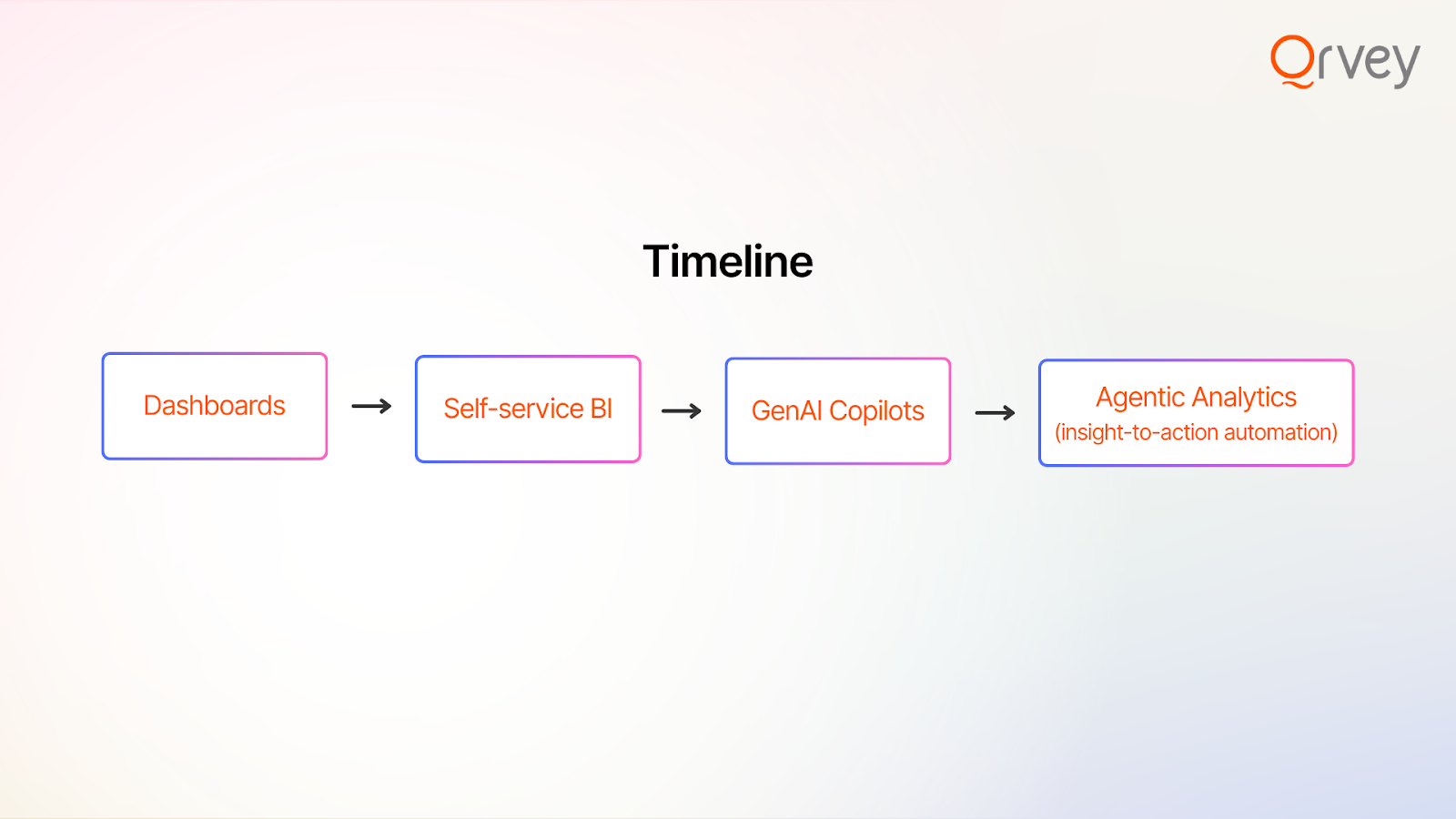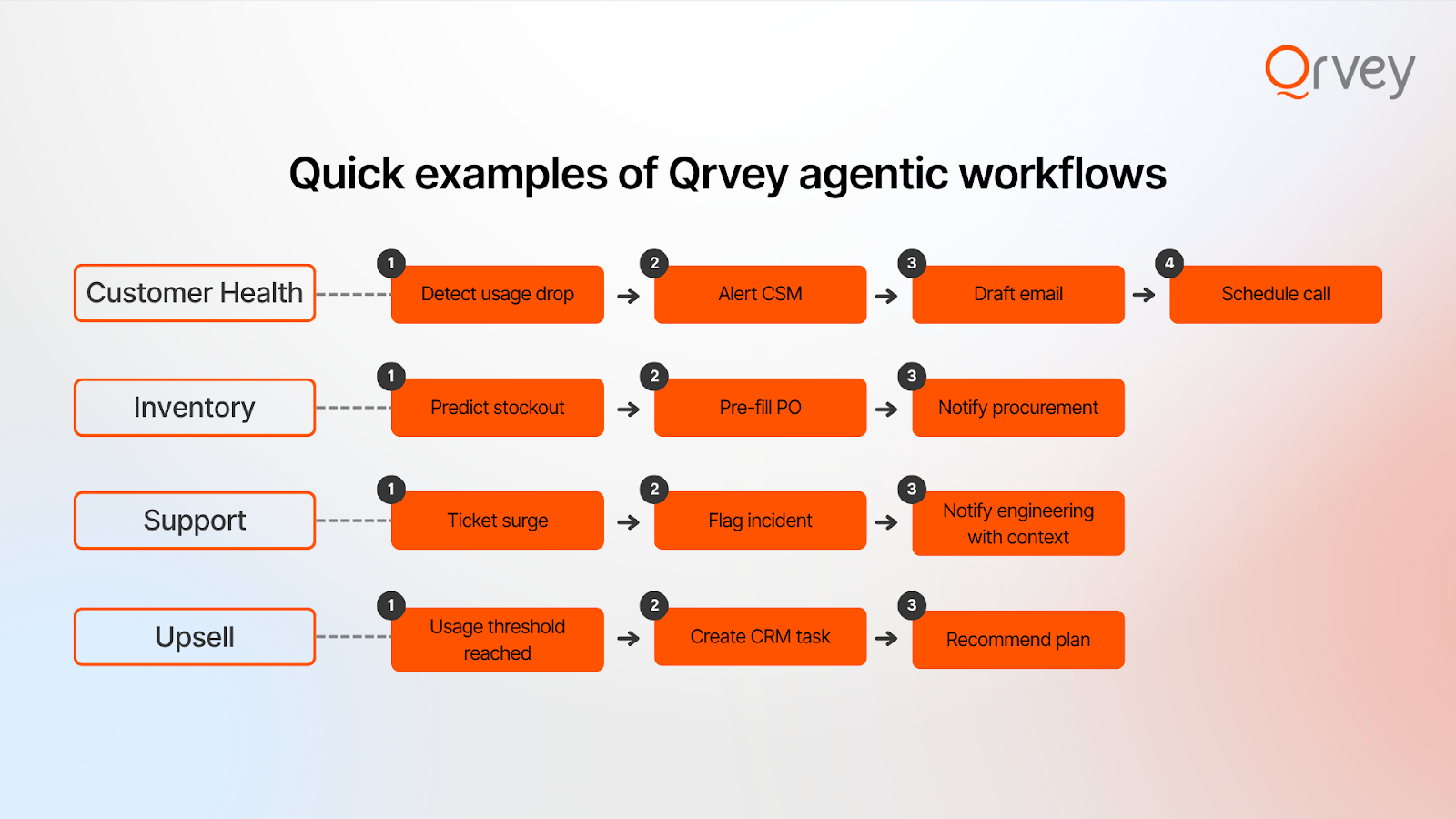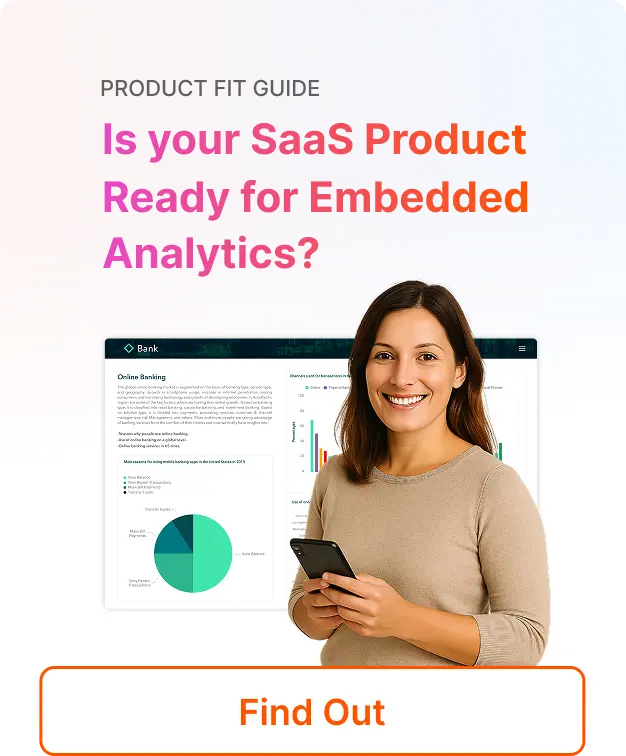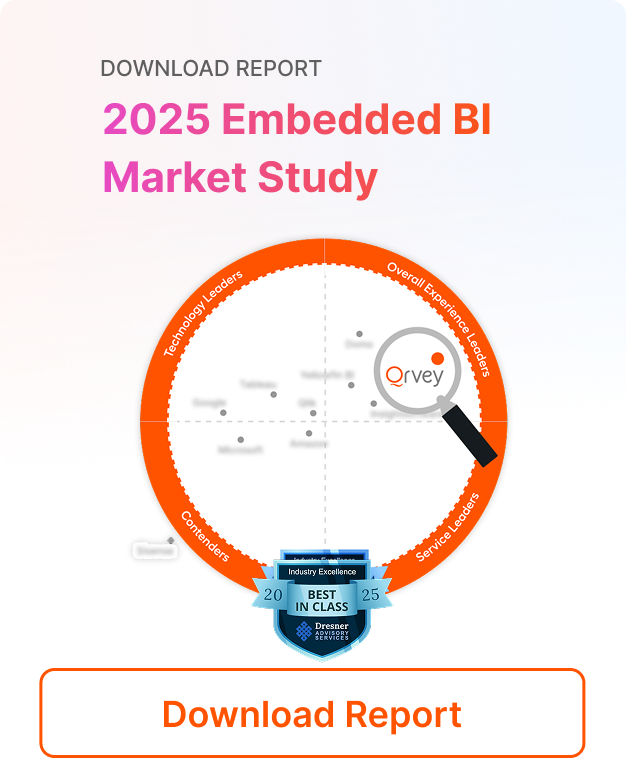
⚡Key Takeaways
- Agentic analytics uses AI agents to monitor data, surface insights, and automate next steps via APIs—closing the loop from insight to action.
- It’s the next stage after dashboards, self-serve BI, and GenAI copilots—from passive reports to proactive, workflow-integrated decisions.
- For SaaS, choosing an API-first, multi-tenant, event-driven analytics platform is critical to support agent workflows today and tomorrow.
- Qrvey was purpose-built for SaaS with NLQ, automated insights, and workflow automation—making it a strong foundation for agentic analytics.
SaaS companies are under intense pressure to infuse AI into their products—pressure from executives, pressure from customers, and pressure from competitors. AI features are no longer a nice‑to‑have; they’re table stakes. The question isn’t if you’ll integrate AI, but where to start.
Analytics—especially agentic analytics—is the perfect entry point. Your users already expect faster time to insight, and AI can deliver that in ways dashboards never could. Many SaaS platforms begin by implementing embedded analytics to bring insights directly into their applications.
Most analytics stop at the moment of insight—leaving teams to swivel to other tools and manually take action. Agentic analytics changes that by giving AI agents the ability to analyze, decide, and trigger actions inside your business workflows. In this guide, you’ll learn what agentic analytics is, how we got here, the core building blocks, and how Qrvey helps SaaS companies adopt it quickly and securely.
What is agentic analytics?
Agentic framework is an AI-driven approach where autonomous analytics or semi-autonomous agents continuously watch your data, surface patterns and anomalies, and initiate workflows (e.g., send alerts, create tickets, update CRMs) through APIs—so decisions don’t stall at dashboards.
The shift toward agentic analytics
Analytics has evolved from dashboards → self-serve BI → GenAI copilots → agentic analytics, where AI agents close the loop by taking action. This shift reflects persistent pain points with manual dashboards, siloed tools, and slow, reactive decisions—especially in multi-tenant SaaS. Agentic analytics moves teams from “find insight” to “insight → decision → action,” often in real time.

For a deeper look at how this transformation plays out in modern platforms, and to see practical agentic AI use cases that illustrate these capabilities, explore our guide on AI for SaaS embedded analytics.
Core elements of agentic analytics
Agentic analytics combines intelligent insight generation, natural language interaction, and workflow automation on an API-first, multi-tenant foundation that supports event-driven operations and agent protocols. Below we take a look at four core elements of agentic architecture.
1) Conversational & generative experiences
Users ask questions in natural language (“What changed last week?”), get visual answers, and can even generate charts/dashboards by prompt—making cloud based analytics accessible beyond specialists and speeding time-to-value.

2) Proactive insight discovery
Agents don’t wait for you to look; they monitor trends, detect anomalies, and flag correlations—so teams move from reactive reporting to proactive action.
3) Integrated actions & workflows
Through API integrations and event triggers, agents initiate next steps—alerts, tickets, orders, CRM updates—closing the loop between analytics and execution.
4) Multi-tenant, API-first architecture
SaaS demands secure tenant isolation, low latency, and complete API coverage so external agents can orchestrate analytics and actions reliably. Without this, agentic scenarios hit scaling and governance walls.
5) Openness to models & agent protocols
Modern stacks support model choice/tuning and explore agent standards (e.g., MCP, A2A) to fit different domains and evolving orchestration ecosystems.
Business Use Cases Powered by Agentic Analytics
Manual handoffs and delayed responses cost time and revenue. Agentic analytics solves this by embedding intelligence directly into workflows. Here are practical examples—all implementable with Qrvey—that show what’s possible.
Customer health & churn prevention
Agents track product usage, license consumption, sentiment, and support history by account. When leading indicators dip—logins, active users, feature adoption—they flag risk, generate a narrative explanation, draft a CSM outreach, open a playbook task in the CRM, and schedule a check‑in.
Inventory & supply chain optimization
Agents forecast demand from orders, sales, and seasonality. When predicted stockouts or supplier delays risk revenue, they draft purchase orders, propose reorder points, and alert procurement. Approved workflows send POs to vendors via API, update ERP levels, and notify customer‑facing teams.
Support surge & incident response
When ticket volume, error rates, or latency spike, agents spot the anomaly and link it to recent releases or affected tenants. They automatically open an incident, page the on‑call team, and gather key context in one place. Status updates start immediately, and post‑mortem templates are prefilled to speed resolution.
Usage-based upsell enablement
Agents watch consumption against tiers and correlate value moments. When thresholds are consistently exceeded or paywalls approached, they calculate projected overage and create an upsell task with recommended plan and timing. Workflows update the CRM, notify the AE, and, if approved, present in‑app upgrade prompts.
Benefits of Agentic Analytics
Agentic analytics isn’t just a technical upgrade—it’s a strategic advantage. By embedding intelligence directly into workflows, it transforms how decisions are made and executed. The benefits go beyond speed; they touch retention, cost efficiency, and governance. Here are the key advantages SaaS companies can expect when adopting this approach.
Faster decisions, less swivel
Moving from dashboard inspection to automated detection + action compresses cycles from days to minutes, improving responsiveness across teams.
Higher retention & product differentiation (for SaaS)
AI-driven analytics features (NLQ, automated insights, workflows) deepen engagement, boost perceived innovation, and open new monetization tiers.
Lower time-to-value & cost efficiency
Generative builders, anomaly detection, and automation reduce onboarding friction and offload complex infrastructure to a specialized platform.
Trust & governance by design
Human-in-the-loop oversight, auditability, and explainability help teams adopt AI responsibly while meeting compliance expectations.
Challenges and What to Watch For
Success with agentic analytics depends on more than technology. It requires anticipating risks and making smart architectural choices. Below are the most critical challenges SaaS teams should prepare for.
Rapidly evolving technologies
The pace of AI innovation is relentless. New models, interaction paradigms, and deployment architectures emerge constantly, making it difficult to predict which will become standard.
This volatility complicates long-term planning and increases the risk of investing in platforms that may quickly become outdated.
Premature removal of human oversight
AI systems are increasingly capable, but removing humans from the loop too early can lead to errors, misinterpretations, and loss of accountability.
Responsible AI design must prioritize transparency, auditability, and human-in-the-loop safeguards to ensure trust and compliance in decision-making workflows.
Vendor lock-in and limited extensibility
As AI features become deeply embedded, switching platforms can become prohibitively complex. Proprietary engines, closed APIs, and limited model flexibility restrict innovation and integration. SaaS companies must prioritize open standards and modular architectures to avoid long-term constraints.
Misalignment with SaaS delivery models
Many analytics platforms were built for enterprise BI, not SaaS. As AI layers are added, security in multi-tenancy, white-labeling, and real-time responsiveness become more pronounced. Choosing platforms optimized for SaaS is critical to avoid delivery friction and scalability issues.
Lack of transparency in AI roadmaps
Vendors often provide vague or incomplete information about their AI strategies. Without clear signals on feature stability, architectural depth, or future direction, SaaS companies face difficulty aligning product strategy with platform capabilities—leading to mismatched expectations and planning missteps.
Implementation Guide for Agentic Analytics
Implementing agentic analytics doesn’t have to be overwhelming. Start with a clear plan and build momentum in stages. The steps below outline a proven approach to move from concept to measurable results.
1) Identify “decision-to-action” hotspots
Map processes where delays are costly (churn, stockouts, incidents). Define signals, actions, and SLAs that agents will target.
2) Choose an AI-ready embedded analytics platform
Prioritize multi-tenant architecture, API-first, event-driven platforms that support NLQ, automated insights, workflow automation, and model flexibility—Qrvey’s embedded analytics platform was designed for this.
3) Instrument events & integrations
Wire data events to triggers and actions via no-code or low-code workflows and SaaS APIs; ensure secure callbacks and audit trails.
4) Start human-in-the-loop
Begin with assistive agents: detect → suggest → require approval. Add autonomy incrementally as confidence grows.
5) Measure outcomes & govern models
Track time-to-action, error rates, and ROI; monitor model drift; document lineage and decisions for transparency.
Bringing Agentic Analytics Into Your business with Qrvey
Qrvey brings NLQ, generative visualization, anomaly detection, forecasting, sentiment analysis, and workflow automation together on a multi-tenant, API-first foundation—precisely the ingredients that make agentic analytics practical for SaaS. With modular services and exploration of agent standards like MCP/A2A, Qrvey helps you deliver insight-to-action experiences without reinventing your stack.
Appendix: Quick examples of Qrvey agentic flows


Arman Eshraghi is the CEO and founder of Qrvey, the leading embedded analytics solution for SaaS companies. With over 25 years of experience in data analytics and software development, Arman has a deep passion for empowering businesses to unlock the full potential of their data.
His extensive expertise in data architecture, machine learning, and cloud computing has been instrumental in shaping Qrvey’s innovative approach to embedded analytics. As the driving force behind Qrvey, Arman is committed to revolutionizing the way SaaS companies deliver data-driven experiences to their customers. With a keen understanding of the unique challenges faced by SaaS businesses, he has led the development of a platform that seamlessly integrates advanced analytics capabilities into software applications, enabling companies to provide valuable insights and drive growth.
Popular Posts
Why is Multi-Tenant Analytics So Hard?
BLOG
Creating performant, secure, and scalable multi-tenant analytics requires overcoming steep engineering challenges that stretch the limits of...
How We Define Embedded Analytics
BLOG
Embedded analytics comes in many forms, but at Qrvey we focus exclusively on embedded analytics for SaaS applications. Discover the differences here...
White Labeling Your Analytics for Success
BLOG
When using third party analytics software you want it to blend in seamlessly to your application. Learn more on how and why this is important for user experience.








